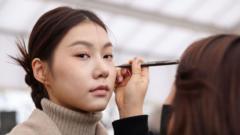The world of South Korean beauty, popularly known as K-beauty, has seen meteoric growth in recent years, drawing in American consumers with its innovative ingredients and effective formulations. However, recent developments in U.S. trade policy, led by former President Donald Trump, are causing ripples through this coveted market.
K-beauty products, which encompass a rich array of skincare, makeup, and cosmetics, are celebrated for their affordability compared to Western products, often featuring unique ingredients such as snail mucin and heartleaf. In 2024, Americans reportedly spent an impressive $1.7 billion (£1.3 billion) on K-beauty goods, highlighting a notable increase of over 50% from the preceding year.
As the allure of K-beauty broadened, it attracted the attention of consumers like Pearl Mak, a 27-year-old graphic designer. "95% of my skincare is made up of K-beauty products," she revealed, which underscores the loyalty this brand delivers, especially compared to harsher Western alternatives.
However, looming tariffs could jeopardize this success story. Trump instituted a 15% import tax on South Korean products, a notable change that has caused retailers to prep for price increases. Cheyenne Ware, founder of K-beauty retailer Santé Brand, reported a surge in orders just after the tariff announcement, indicating a proactive consumer response to the anticipated cost shifts.
Analysts warn that small sellers, particularly those on platforms like Amazon, will grapple with passing increased costs onto consumers, a challenge that may reshape buying habits. "Anyone telling you prices will stay flat... is naive,” said Ware, hinting at the inevitable price adjustments that consumers can expect.
Despite these concerns, experts believe that the cultural allure of K-beauty will sustain its popularity. Munseob Lee, an economist from UC San Diego, observed that while casual buyers might hesitate due to rising prices, devoted fans are likely to remain loyal. Preferences voiced by Mak reinforce this perspective: "It depends on how much the price shoots up, but as of now, I am willing to pay more to purchase the same products."
Yet, the disparity between larger K-beauty brands and smaller enterprises is noticeable. Larger corporations can absorb these tariff-related costs more efficiently, while smaller firms might face steep challenges, especially in maintaining competitive pricing. Eyal Victor Mamou, a business consultant based in South Korea, noted that the effects of these tariffs would unfold gradually as current products have already been priced out.
A recent move by Trump to extend the same tariff rates to cosmetics from major competitors like Japan and the European Union further complicates the landscape. With K-beauty products facing competition from U.S. goods, the critical question remains whether consumers will gravitate towards American brands. So far, it seems that American-made options do not yet measure up, at least in the eyes of dedicated K-beauty fans who continue to value the effectiveness of their preferred products over domestic alternatives.
As the future of K-beauty hangs in the balance, one thing remains clear: the devotion of its consumer base may help navigate the storm, even as pricing dynamics shift in a complicated trade environment.




















